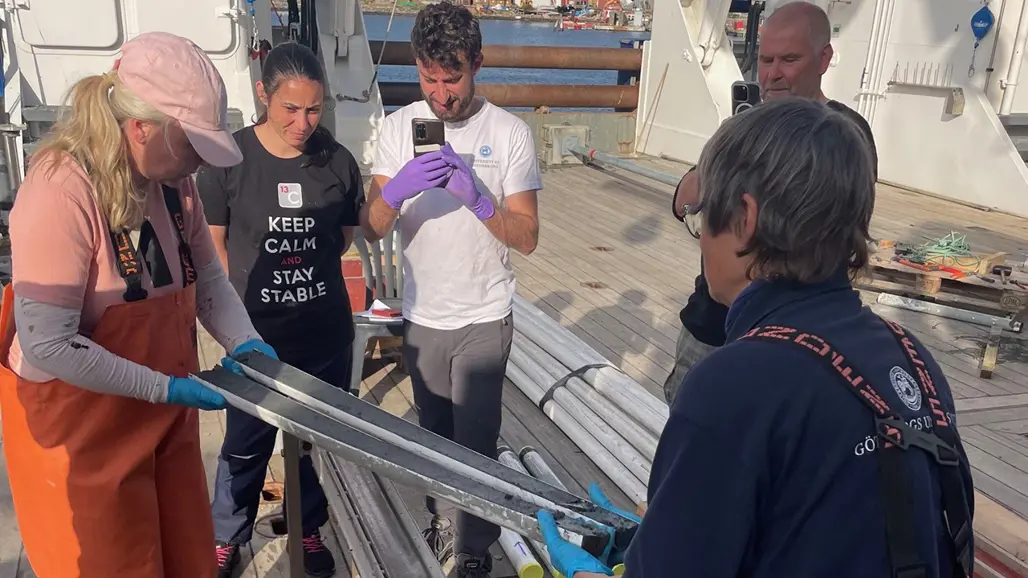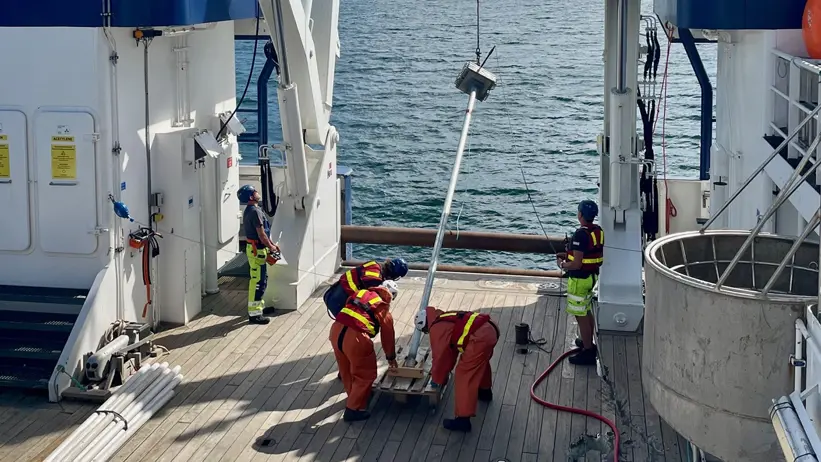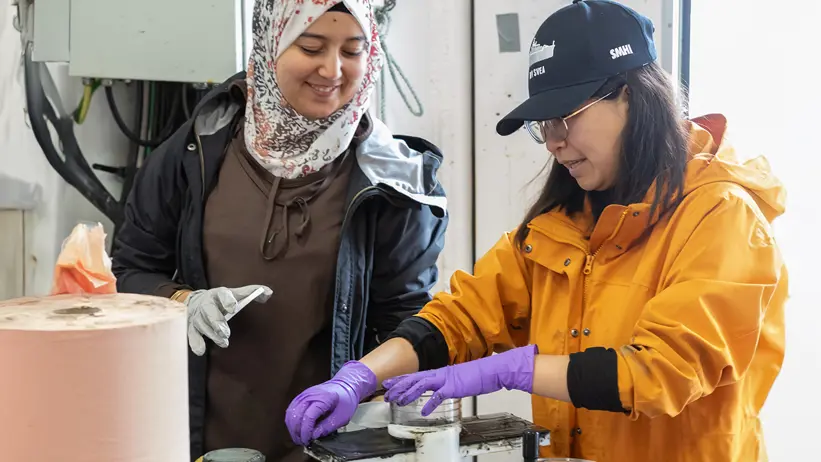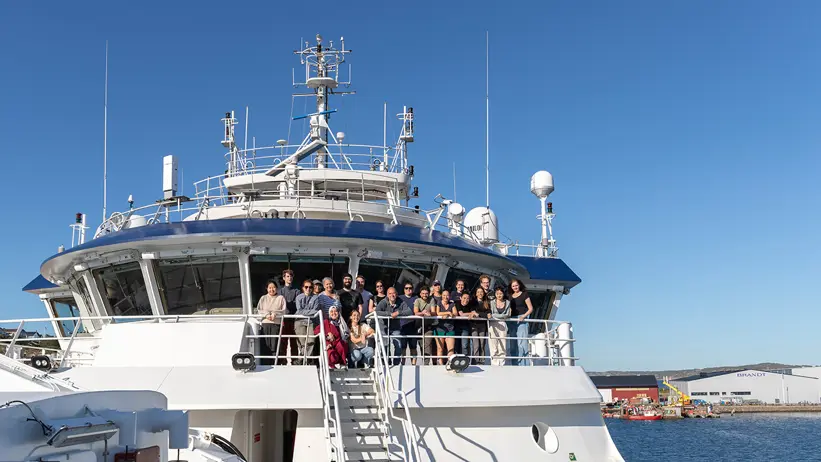
Climate clues and microbial mysteries – Svea’s first SWERVE expedition completed
During the summer, two research teams carried out an intensive expedition aboard the Swedish research vessel R/V Svea, spending a week investigating what happens beneath the surface in the fjords along Sweden’s west coast.
In refrigerators across the country, long sediment cores from fjord bottoms are now awaiting analysis – samples that act as historical records. Onboard, a new instrument was also tested, capturing more than 50,000 images of plankton. Work is now continuing onshore to identify the different species.
This was the first expedition carried out within SWERVE – a Swedish national research infrastructure that provides researchers with access to ship time. The cruise took place during the first week of July, with sampling stations in several fjords, including Gullmarn and Idefjorden.
Despite some seasickness, and initial technical issues, all planned fjords were successfully investigated. On board, the researchers worked intensely to collect water samples and sediment cores – from the sea surface all the way down to the seabed.

"In the BIOX project we were looking for hypoxic water layers – water with very low oxygen levels – to study how microbial communities function in deoxygenated environments. The first fjords we studied had low oxygen but were never truly hypoxic. In Idefjorden we finally found what we were looking for, a hypoxic layer in the inner fjord. It was a very exciting moment, as this fjord had previously been completely anoxic and sulfidic, but has recovered over the last decades. Finding those seasonal low-oxygen layers is key to understanding that process," says Eric Capo, researcher at Umeå University and leader of one of the two research teams.
What can fjord sediments tell us?
Eric Capo heads the interdisciplinary team studying how oxygen-depleted conditions affect microorganisms in fjords – both today and over time. Fjords are naturally vulnerable to oxygen loss, and by analysing water samples and sediment cores, the researchers aim to understand how microbial communities behave in low-oxygen conditions. The goal is to map how this, in turn, influences emissions of greenhouse gases such as methane and nitrous oxide, and the formation of environmental toxins like methylmercury.

During the expedition, samples were collected from six fjords – from surface waters down to anoxic bottom sediments – to examine both chemical conditions and microbial biodiversity. By combining analyses of today’s microorganisms with genetic traces in the sediments, the researchers hope to track long-term changes and better anticipate the future effects of environmental change.
"Deoxygenation in coastal waters is a growing problem, driven by climate warming and local pollution. It’s crucial to understand both the past and present effects of oxygen loss on ecosystems so we can better project future changes. Among the consequences are increased greenhouse gas emissions and the formation of pollutants – two major issues where we need more knowledge if we are to guide society and limit human impact," says Eric Capo.
Hunting for tomorrow’s antibiotics
The second research team, led by Carina Bunse at the University of Gothenburg, focused on a group of marine bacteria called Actinomycetota. These microorganisms are known producers of antibiotics, but the ecology of their marine relatives remain poorly studied. By examining how they interact with other microbes in the ocean, the researchers hope to discover new compounds – potentially even novel antibiotics.
During the expedition, water, plankton, and sediment were collected from various depths and are now being analysed in the lab. The goal is to isolate bacteria, sequence their DNA, and study their metabolite production under different environmental conditions.
"It is exciting to study the microbial biodiversity at the Swedish West Coast that is mostly hidden from our sight. Microbial genomes in the ocean are a potential gold mine for new discoveries." says Carina Bunse.

Svea – a platform for discovery
The expedition material is now being analysed at several research institutions across Sweden, and the researchers expect the results to lead to both scientific publications and new research questions.
"With this SWERVE project we wanted to take a truly holistic approach to studying fjords – combining cutting-edge biogeochemistry and microbial ecology, both from modern and historical perspectives. One of the great outcomes of the cruise is that it has strengthened collaboration between several Swedish universities, something we hope will continue long after the project," says Eric Capo.

The research vessel Svea also played a central role in making the expedition possible.
"Svea’s crew gave our highly international research group a fantastic welcome – only two of the 20 participants were Swedish – and they ensured that the complex sampling programme could be carried out smoothly. We learned a lot from each other during the week, and the interactions on board added great value to the science," says Eric Capo.
Carina Bunse agrees:
"We are very grateful for the fantastic Svea expedition and the opportunity that SWERVE gave us. Thanks to the vessel’s size, flexibility and experienced crew, both projects could be carried out in parallel, which led to new collaborations and even stronger scientific results," says Carina Bunse.
The successful expedition has also been significant from Svea’s and SLU’s perspective.
"We are proud to be able to offer a research platform that meets both current and future needs. The SWERVE expedition demonstrates the breadth of research Svea can support and how valuable well-planned joint initiatives at sea can be," says Björn Lindell, research vessel coordinator at SLU.
Contact
-
Person
-
PersonMattias Sköld, researcherInstitute of Marine Research, joint staff